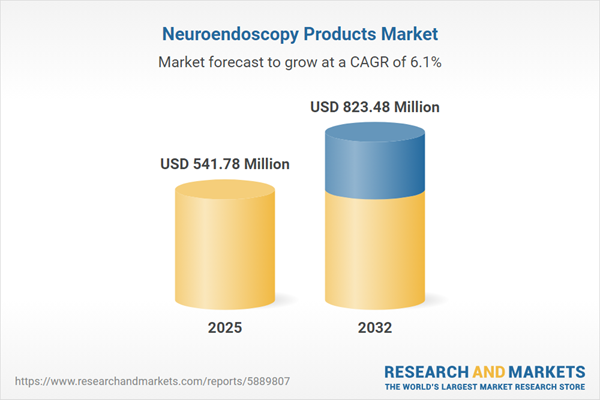Speak directly to the analyst to clarify any post sales queries you may have.
The neuroendoscopy products market is undergoing significant transformation, fueled by evolving clinical needs and heightened demands for sophisticated healthcare procurement. Senior leaders are navigating a rapidly changing landscape, balancing investment priorities with operational efficiency to maintain excellence in neurosurgical care.
Market Snapshot: Neuroendoscopy Products Market Growth and Trends
The neuroendoscopy products market is expanding steadily, closely aligned with the increasing shift toward minimally invasive neurosurgical techniques. Healthcare providers ranging from large hospitals to ambulatory surgical centers are actively seeking endoscopic solutions that increase visualization capabilities and enhance procedural workflows. The integration of modular, upgradable equipment and digitally enabled surgical platforms is transforming procurement protocols and operational decisions. As the environment becomes more sophisticated, fostering alignment between supply chain teams and clinical staff offers clear opportunities for raising care quality and elevating institutional competitiveness.
Scope & Segmentation: Comprehensive Overview of the Neuroendoscopy Products Market
- Product Type: Flexible endoscopes in reusable or single-use variants, alongside rigid digital and fiber optic devices, address diverse surgical requirements. Supplementary tools—including forceps, scissors, retractors, and irrigation instruments—empower comprehensive coverage for cranial and spinal procedures.
- Application: These systems are core to adult and pediatric neurosurgical treatment, facilitating skull base and pituitary operations, acoustic neuroma cases, ventricular tumor biopsies, and hydrocephalus interventions. Spinal applications are also expanding within this segment.
- End User: Academic medical centers, public and private hospitals, outpatient surgical sites, and specialist clinics are pivotal users. These organizations increasingly emphasize optimizing clinical workflows and reducing risk when shaping procurement and technology adoption strategies.
- Distribution Channel: Digital procurement channels and integrated supply chain solutions simplify acquisition, improve inventory management, reduce lead times, and enhance the effectiveness of purchasing activities within healthcare systems.
- Geographical Coverage: The market maintains high activity across the Americas, Europe, and Asia-Pacific, with new growth emerging in the Middle East and Africa. Asia-Pacific, notably led by China, India, Japan, Australia, and Southeast Asia, experiences accelerated expansion through infrastructure improvements and progressive regulation. Healthcare enhancements and administrative reforms in Africa are also driving demand for advanced neurosurgical options.
- Key Players: Karl Storz GmbH & Co. KG, Stryker Corporation, Olympus Corporation, Richard Wolf GmbH, Medtronic plc, Brainlab AG, Integra LifeSciences, CONMED Corporation, Smith & Nephew plc, and B. Braun Melsungen AG contribute to ongoing product innovation and global market presence.
Key Takeaways: Strategic Insights for Senior Decision-Makers
- Cloud-based imaging and analytics strengthen case management, offering multidisciplinary teams faster and better-coordinated decisions during neuroendoscopic interventions.
- Artificial intelligence and robotic technology adoption improves the precision and reliability of intricate cranial procedures, contributing to consistently strong outcomes.
- Single-use instruments are preferred for infection prevention and to shorten procedural cycles, advancing patient safety and supporting compliance objectives.
- Procurement strategies are increasingly influenced by regulatory requirements, supplier partnership quality, and facility infrastructure, guiding risk management and capital planning for institutions.
- Modular device platforms with interoperability features provide flexibility to accommodate regulatory updates and technology changes, promoting supply chain efficiency and robust performance in varied care settings.
- Manufacturer-clinician collaboration accelerates the effective uptake of new endoscopic equipment and enables targeted staff training across neurosurgical teams.
Tariff Impact: U.S. Neuroendoscopy Procurement Considerations
Recent U.S. tariff policies have heightened the complexity of sourcing neuroendoscopy components. U.S. healthcare organizations respond by expanding manufacturing partnerships, strengthening supplier relationships, and applying risk mitigation protocols that help secure access to essential neurosurgical technologies.
Methodology & Data Sources
This report utilizes quantitative market research, detailed industry expert interviews, end-user feedback, and evidence from major device manufacturers. This method ensures relevance and delivers actionable market intelligence for every stakeholder in the neuroendoscopy supply chain.
Why This Report Matters: Executive Value and Benefits
- Enables executive leadership to anticipate shifts in market, regulatory, and technology trends shaping future neurosurgical operations.
- Equips institutional decision-makers with intelligence for shaping supply chain policies that fulfill compliance demands alongside operational objectives.
- Supports evidence-based decisions for adopting advanced neuroendoscopy tools, contributing to optimized outcomes in high-complexity neurological care settings.
Conclusion
This analysis delivers targeted insights for executives and procurement leaders, empowering confident technology selection and procurement in a demanding neuroendoscopy products market.
Additional Product Information:
- Purchase of this report includes 1 year online access with quarterly updates.
- This report can be updated on request. Please contact our Customer Experience team using the Ask a Question widget on our website.
Table of Contents
3. Executive Summary
4. Market Overview
7. Cumulative Impact of Artificial Intelligence 2025
Companies Mentioned
The companies profiled in this Neuroendoscopy Products market report include:- Karl Storz GmbH & Co. KG
- Stryker Corporation
- Olympus Corporation
- Richard Wolf GmbH
- Medtronic plc
- Brainlab AG
- Integra LifeSciences Holdings Corporation
- CONMED Corporation
- Smith & Nephew plc
- B. Braun Melsungen AG
Table Information
| Report Attribute | Details |
|---|---|
| No. of Pages | 184 |
| Published | October 2025 |
| Forecast Period | 2025 - 2032 |
| Estimated Market Value ( USD | $ 541.78 Million |
| Forecasted Market Value ( USD | $ 823.48 Million |
| Compound Annual Growth Rate | 6.1% |
| Regions Covered | Global |
| No. of Companies Mentioned | 11 |









